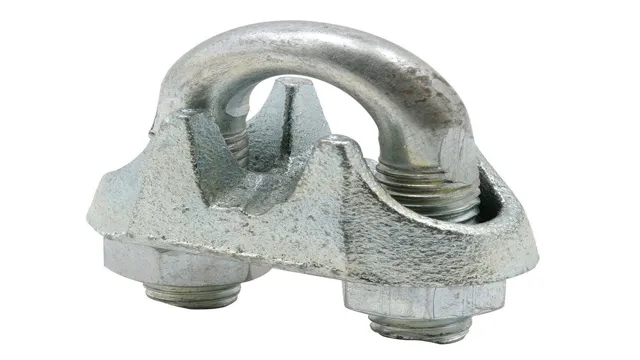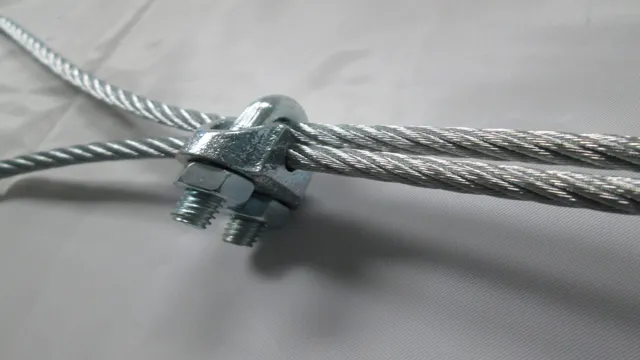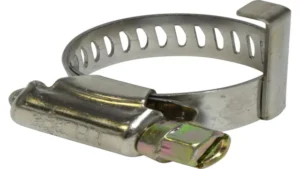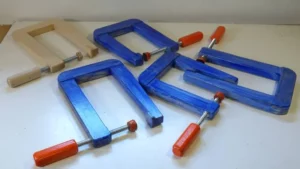Cable management can be a nightmare, with cords and wires snaking around in every direction. But with the right tools, you can easily tame the tangle of cables and keep everything organized. One essential tool for cable management is the cable clamp.
These little devices are easy to use and can make a big difference in keeping your workspace tidy. In this step-by-step guide, we’ll walk you through everything you need to know about using cable clamps. Whether you’re a tech-savvy professional or just looking for a way to tidy up your home office, this guide will help you get started.
So let’s dive in and learn how to use cable clamps like a pro!
What are cable clamps?
Cable clamps are essential tools used to organize and secure cables in a neat and tidy manner. They come in different forms and shapes, such as plastic, metal, or rubber, and they’re designed to fit around bundles of wires or single cords. There are a few different ways you can use cable clamps, including attaching them to a surface or strapping them around a larger group of cables.
Cable clamps are particularly helpful in situations where there is a lot of electrical equipment, such as computer desks, television sets, or even in cars. They help to keep cables untangled, which reduces the risk of electric shocks and tripping hazards. Overall, cable clamps are easy to use, and with proper installation, they can make the difference between a chaotic and disorganized workspace and a neat and clean one.
Definition and types
Cable clamps are devices that are used to secure and organize cables or wires. These clamps are made from various materials such as plastic, metal, and rubber, and they come in different sizes and shapes to cater to various cable types. Cable clamps are used in different locations, including homes, offices, factories, and vehicles, to keep cables organized and protect them against damage.
They can be used to secure cables to walls, ceilings, floors, or any other surface. The main types of cable clamps include adhesive cable clamps, cable tie mounts, plastic cable clamps, metal cable clamps, and rubber-lined clamps. Adhesive cable clamps typically feature a sticky backing that allows them to be easily attached to surfaces.
Cable tie mounts, on the other hand, feature small loops that allow cable ties to be easily passed through and secured. Plastic cable clamps are lightweight and cheap, making them a popular choice for organizing cables at home. Meanwhile, metal and rubber-lined clamps provide more holding strength and durability, making them ideal for industrial and vehicular applications.

Sizes and materials
Cable clamps are small, yet essential, tools that help you organize and secure cables. They’re especially useful for home theaters, offices, or other areas with lots of electronic gadgets. Cable clamps come in different sizes and materials, which allow you to choose the best fit for your needs.
The most common materials are plastic and rubber, both of which offer good elasticity and durability. Metal clamps are more robust and can withstand heavy loads, but they may be too rigid for some cables. When selecting cable clamps, be sure to consider the size and thickness of your cables and the environment in which they’ll be used.
If you’re not sure which type of cable clamp to choose, a knowledgeable salesperson can usually help guide you in the right direction. With the right cable clamps, you’ll be able to keep your cables tidy and organized while reducing the risk of damage or interference.
Tools and materials needed
If you’re planning to use cable clamps for the first time, you may be wondering what tools and materials are needed to get the job done. Firstly, you’ll need to have your cable or wire ready to be clamped, whether it’s for organization or protection purposes. Depending on the type of clamp you’re using, you may require a pair of pliers, wire cutters, or crimping tool to fasten the clamp securely.
It’s also recommended to have a surface to work on, such as a workbench or table, and some protective equipment such as safety goggles and gloves. Lastly, make sure you have enough clamps for your intended project, as you don’t want to run out halfway through. By having these tools and materials ready, you can ensure a successful and efficient use of cable clamps for your project.
List of required items
If you are planning on tackling a DIY project, it is essential to have the right tools and materials on hand. Depending on the project, you may need a variety of items, such as a saw, hammer, drill, screws, nails, sandpaper, and paint brushes. It is crucial to have these tools properly maintained and organized, so finding them when needed is quick and efficient.
Additionally, make sure to invest in high-quality materials to ensure the longevity and success of your project. Skimping on cheap materials may result in a lackluster finished product or, worse, potential safety hazards. Don’t forget to wear protective gear, such as gloves and goggles, to keep yourself safe while working.
With the right tools and materials at your disposal, your DIY project will be off to a solid start.
Steps to using cable clamps
If you’re working on a project that requires cable management, you’re going to need cable clamps. Cable clamps are handy tools that keep wires and cables in place and prevent them from becoming tangled or damaged. Using them is relatively easy.
Start by selecting the appropriate size clamp for your cables and wires. Next, open the clamp and snap it around the cable, ensuring that it’s secure. Be sure to avoid over-tightening the clamp, as this can damage your cables.
If your project requires cable organization, start by bundling your cables together. Once you’ve created a bundle, loop a cable clamp around them and tighten it. Repeat this process until all of your cables are secured in place.
With a bit of patience, you can easily manage your cables and wires with cable clamps.
Step 1: Gather all cables and clamps
When it comes to using cable clamps, the first step is to gather all the necessary materials. This includes cables and clamps, of course, but also any other tools or supplies you may need, such as pliers or a screwdriver. Once you have everything in one place, you can start the process of securing your cables with the clamps.
This is an important step to take, as it helps to keep your cables organized and prevents them from becoming tangled or damaged. It also ensures that your cables are free from interference, which can impact the quality of your signal. So, don’t skip this important step and make sure you have everything you need before you start using your cable clamps.
By doing so, you’ll be well on your way to achieving a tidy and reliable cable setup.
Step 2: Position the cables
Once you’ve chosen the right cable clamp for your specific needs, it’s time to position the cables. This step is crucial to ensuring that the cables are held securely and won’t come loose over time. Start by deciding where you want to place the clamp – this will depend on the location and size of the cables you’re working with.
Next, use a screwdriver or drill to attach the clamp to a surface, such as a wall or desk. Make sure the clamp is fastened tightly to avoid any wobbling or movement. Then, carefully thread the cables through the clamp, making sure they are all aligned and organized in the way you want them.
Finally, tighten the screws or clamps on the cable to hold them in place. By following these steps, you’ll be able to safely and securely organize your cables using cable clamps.
Step 3: Open the clamp
As we move on to the next step in using cable clamps, we need to understand the importance of opening the clamp. The third step is as crucial as the previous ones. Opening the clamp will give you access to the cables that have been tied in it, allowing you to add or remove them as per your requirement.
To open the cable clamp, you need to press the tab or lever on the side of the clamp, which will loosen the grip of the clamp on the cables. Once you have opened the clamp, you can adjust the cables and make changes as needed before closing the clamp. This step is especially important when you are trying to fix a cable in a difficult-to-reach area.
In such cases, it can be challenging to insert and adjust the cables, but opening the clamp will make it easier for you to work on them. As always, make sure to handle the cables with care to avoid any damage or accidental cuts. Properly opening and closing the clamp will ensure your cables are secure and well-organized.
Step 4: Place the cables in the clamp
When it comes to using cable clamps, one of the key steps is placing the cables in the clamp. This may seem like a no-brainer, but it’s important to do it correctly to ensure the cables are securely held in place. First, make sure you have the right size clamp for your cables.
If the clamp is too small, it won’t hold the cables tightly enough and they could slip out. If it’s too big, the cables may not fit securely and could move around. Once you have the right size clamp, open it up and place the cables inside, making sure they are evenly spaced and not overlapping.
Then, close the clamp securely, making sure it’s tight enough to hold the cables in place but not so tight that it damages the cables. With the cables securely clamped in place, you can feel confident that they will stay put and won’t become tangled or damaged over time. So don’t overlook this key step when using cable clamps – it’s an essential part of ensuring that your cables are organized, tidy, and easy to manage.
Step 5: Tighten the clamp
When using cable clamps, it’s important to tighten them properly, or else they won’t be effective. To do this, first ensure that the ends of the cable are properly aligned and held in place within the clamp. Then, using a screwdriver or wrench, turn the screws clockwise to gradually tighten the clamp around the cable.
Be careful not to overtighten, as this can damage both the cable and the clamp, but ensure that the clamp is tight enough to hold the cable securely in place. A loose clamp can lead to cable slippage or even failure. Taking the time to properly tighten each clamp will ensure the safety and reliability of your cables.
Tips for using cable clamps
Cable clamps are a necessity when it comes to managing cables and cords in your workspace. But if you don’t know how to use them properly, they could be more of a hassle than a help. The first thing you need to do is determine the size of the cable or cord you need to manage.
Once you have that, choose the appropriate size clamp. Next, wrap the clamp around the cable and tighten it enough to keep the cable in place, but not so much that you damage the cable. It’s important to position the clamp in the right spot, too.
If it’s too close to the end of the cable it can cause the cable to fray, but if it’s too far away it won’t be effective. By following these simple tips, you can make the most of your cable clamps and keep your workspace organized and tidy.
Precautions to take
When it comes to cable clamps, it’s important to take certain precautions to ensure they’re being used correctly. First and foremost, it’s important to choose the right size clamp for the cable being secured. Using a clamp that is too small can damage the cable, while using one that is too large can result in the cable not being secured properly.
Additionally, it’s important to make sure the clamp is tightened enough to hold the cable securely, but not so tight that it damages the cable. Another important tip is to make sure the cable being secured is clean and free of debris before clamping. This will ensure a better grip and prevent the cable from slipping out of the clamp.
Lastly, it’s a good idea to periodically check the clamps to make sure they’re still holding the cables securely and haven’t become loose over time. By following these tips and taking the proper precautions, cable clamps can be an effective and safe tool for managing cables.
Maintaining and replacing clamps
Maintaining and replacing cable clamps is crucial to ensure the safety and efficiency of your cables. Here are some tips to help you use cable clamps effectively. Firstly, it’s crucial to choose the right type of clamp for your cables.
This will depend on the size and shape of the cable, as well as the environment in which it will be used. Secondly, make sure you inspect your clamps regularly. Check for any signs of wear and tear or damage.
This can be done by visually inspecting the clamp or by testing its ability to hold the cable securely. Finally, when replacing clamps, make sure to use high-quality and properly sized ones. Using inferior clamps can result in the cable slipping out or failing, which can cause injury or damage.
By following these tips, you can ensure the safety and reliability of your cables.
Conclusion
Whether you’re an expert in DIY or a cable-clamp novice, these handy little devices can make all the difference in your next project. Just like how a safety belt keeps you securely fastened while driving, cable clamps keep your cables and wires organized, tidy, and secure. With the right size and application, you can rest assured that your cables will stay put without any tangling or damage.
So don’t let loose wires and confused cords drive you up the wall – grab some cable clamps and keep your cables under control!”
FAQs
What are cable clamps?
Cable clamps are a type of hardware used to secure wires and cables in place.
What are the different types of cable clamps?
Cable clamps come in various types, such as plastic clamps, metal clamps, adjustable clamps, and adhesive clamps.
What is the purpose of cable clamps?
The primary purpose of cable clamps is to organize and secure cables to prevent them from moving around or getting tangled.
How do you install cable clamps?
To install a cable clamp, first, determine the size and type of clamp you need, then open it up and place the cables inside before closing and fastening it in place.
Are cable clamps reusable?
Yes, most cable clamps are designed to be reusable, so you can use them again and again.
Can cable clamps withstand extreme temperatures?
Depending on the material and type of cable clamp, it can withstand different temperatures. For instance, plastic cable clamps are best suited for indoor use, whereas metal clamps are ideal for outdoor use because they can withstand extreme temperatures.
Where can I buy cable clamps?
You can buy cable clamps from any hardware store, online retailers, or electrical suppliers.






